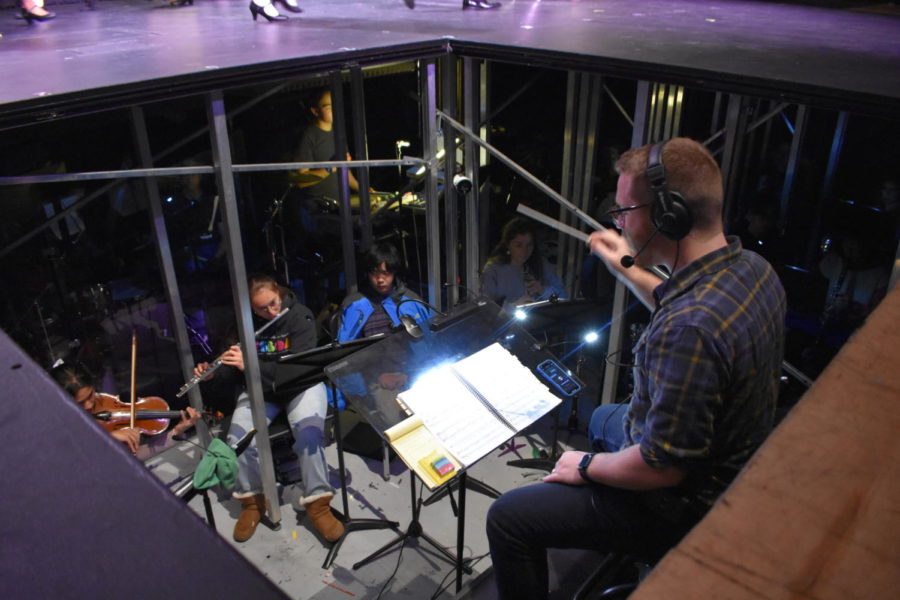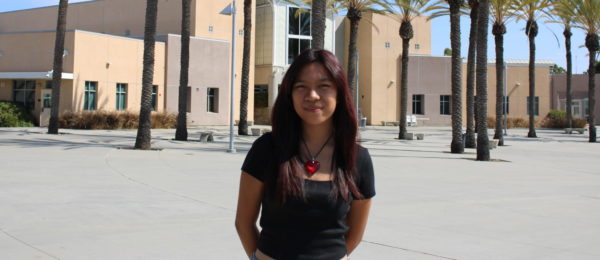Pit orchestra performs with WVTC for Beauty and the Beast
April 7, 2023
In the theater, the orchestra pit is located underneath the main stage, and the entrance can be found behind the half-wall on the right side of the theater. Seldom used, this cave is occupied more by spiders and dust mites than by students.
17 GOLD members shuffled their way into the theater and were met with the once-hidden staircase, now visible. The stairs that went down to the room were steep, and the students had to duck to be able to enter the room. It was dark upon entering—all they could see was the indistinct shape of the storage items occupying the room. They had to maneuver their way around all of the metal support beams that were holding up the stage itself. The tech crew had to take a panel off the stage to allow the conductor to see what was happening on the stage. When the students first entered it on March 23, they said it seemed like no one had been in there for years—which was true, since no one had played music there since before the pandemic. However, the musical drought was over because this was where the pit orchestra would be accompanying the Westview Theater Company in this year’s production of Beauty and the Beast.
Students volunteered to be a part of the ensemble and Carmela Harkins (12), who plays the flute, said that she wanted to volunteer when she heard good things from alumni who got the chance to play for the pit orchestra. The ensemble consists of two keyboards, two flutes, two clarinets, two trumpets, two percussionists, a violin, a piccolo, a cello, a string bass, a French horn, an oboe, a bass clarinet, and an English horn. The group started rehearsals in February, initially practicing in the band room with the band director Mitchell Way. However, because Daniel Moyer, the vocal director of Beauty and the Beast, would be the one conducting during the show, eventually there was a transition between Way’s direction and Moyer’s.
“[Way] and I traditionally have taken turns doing the conducting in the pit orchestra when everything comes together for tech rehearsal,” Moyer said. “Way was the conductor of Kiss Me Kate, [the last musical with a pit orchestra].”
On March 21, the orchestra started rehearsing with Moyer and they first had a sitzprobe, which is a rehearsal where they had the orchestra and the vocalists run through the music together for the first time. After that, they held two rehearsals while practicing in the pit before opening night.
“Working with a pit and a conductor adds another level of complexity to what the actors have to do on stage when they’re singing and when they’re doing their lines,” Moyer said. “In [Beauty and the Beast, the] score [has] rather a few scenes that have spoken dialogue with music [accompanying] it.”
As the conductor, Moyer has to make sure that the music and the acting align with one another.
“There’s action going on the stage and they cannot see the orchestra, and the orchestra cannot see what is happening on the stage,” Moyer said. “So I’m sort of like the in-between, trying to communicate with the people up top and the people down below in the pit.”
Since the main source of light coming into the pit is from the main stage, there is a limitation on the students’ range of vision. To help assist them, each has a stand light—similar to reading lights—that allow them to read their sheet music.
Veronica Pavlicek (12) plays both the English horn and oboe and has to switch from one to the other throughout the musical. She said that she sometimes even has to switch during one song.
“It’s not too difficult,” Pavlicek said. “I’m just really busy throughout because I play in every song. There are a few impossible instrument switches where I’ve had to leave out one or two measures because I physically don’t have enough time.”
Students playing in the pit orchestra were used to strictly following what was written on their sheet music, but when working in tandem with singers, they often have to make adjustments.
“[Playing with vocalists is] the most challenging part probably because we have to adjust our tempo to their singing,” Pavlicek said. “So you just have to really pay attention to all the cues [Moyer gives].”
Moyer said that being able to bring back this aspect of the musical production has been a fun adventure.
“[By] having live instruments in the space, there’s just something about the sound that you can’t really mimic with just a recording that you’re playing through your PA system,” Moyer said.
To be a part of a momentous event, Harkins said that she was grateful to be able to experience it before she graduated this year.
“There’s really nothing like it because normally you’re just following the conductors,” Harkins said. “But for a theater, you follow the vocalists, and everything you play backs up their part. It’s really cool how everything creates a whole [production] together [and] it’s just cool to be a part of the show even though you’re not on stage.”



